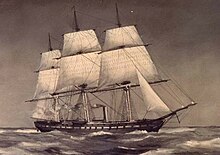USS Wabash (1855)

Wash drawing in grey tones by Clary Ray, circa 1900, showing USS Wabash under steam and sail
|
|
| History | |
|---|---|
|
|
|
| Name: | USS Wabash |
| Namesake: | A river that rises in Drake County, Ohio, near Fort Recovery. |
| Builder: | Philadelphia Navy Yard |
| Laid down: | May 16, 1854 |
| Launched: | October 24, 1855 |
| Sponsored by: | Miss Pennsylvania Grice |
| Commissioned: | August 18, 1856 at Philadelphia, Pennsylvania |
| Recommissioned: | October 24, 1871 at Boston, Massachusetts |
| Decommissioned: | April 25, 1874 at the Boston Navy Yard |
| Struck: | November 15, 1912 |
| Fate: | Sold, November 15, 1912 at Boston. |
| General characteristics | |
| Class and type: | Colorado |
| Type: | Screw frigate |
| Displacement: | 4,808 tons |
| Length: | 301 ft 6 in (91.90 m) |
| Beam: | 51 ft 4 in (15.65 m) |
| Draft: | 23 ft (7.0 m) |
| Propulsion: | steam engine, and schooner sail |
| Speed: | 9 knots (17 km/h; 10 mph) |
| Complement: | 642 |
| Armament: |
|
| General characteristics 1863 | |
| Class and type: | none |
| Armament: |
|
| General characteristics 1865 | |
| Class and type: | none |
| Armament: |
|
USS Wabash was a steam screw frigate of the United States Navy that served during the American Civil War. She was based on the same plans as Colorado. Post-war she continued to serve her country in European operations and eventually served as a barracks ship in Boston, Massachusetts, and was sold in 1912.
Wabash—the first U.S. Navy ship to bear that name—was laid down on May 16, 1854 by the Philadelphia Navy Yard; launched on October 24, 1855, sponsored by Miss Pennsylvania Grice; and commissioned there on August 18, 1856, Captain Frederick K. Engle in command.
Wabash departed Philadelphia, Pennsylvania on September 7, 1856, stopping at Portsmouth, New Hampshire, to embark President Franklin Pierce for passage to Annapolis, Maryland. She arrived at New York on October 23, 1856, sailing on November 28, 1856 to become flagship of Commodore Hiram Paulding's Home Squadron. The squadron was instrumental in foiling the expedition against Nicaragua underway by American filibuster, William Walker, who had dreamed of uniting the nations of Central America into a vast military empire led by himself. Through insurrection, he became president of Nicaragua in 1855 only to have Cornelius Vanderbilt—who controlled the country's shipping lifelines—shut off supplies and aid. A revolt toppled Walker from power, and he was trying for a military comeback before he was captured in 1857 by the Home Squadron. Stateside controversy over the questionable legality of seizing American nationals in foreign, neutral lands prompted President James Buchanan to relieve Commodore Paulding of his command. Wabash was decommissioned on March 1, 1858 at the New York Navy Yard.
...
Wikipedia
